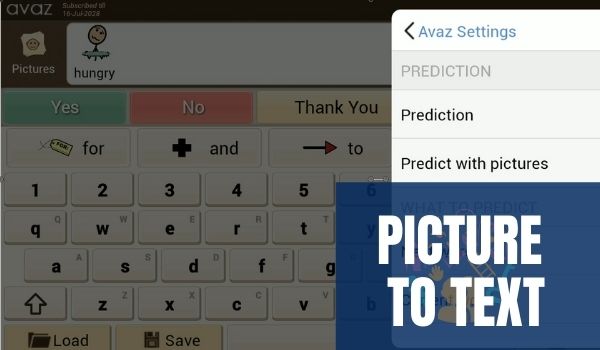While so much is being said about introducing literacy to an AAC user from early on, we are often confused as to what it looks like and where to begin.
No single intervention will have as dramatic effects on a student’s future as a solid foundation in literacy (Heller, Fredrick, Tumlin, & Brineman, 2002).
Currently, 90% of individuals with CCN (Complex Communication Needs) enter adulthood without acquiring functional literacy skills (Foley & Wolter, 2010).
It’s obvious that we cannot underestimate the value of literacy instruction for our AAC learners.


So, let’s go right ahead and look at some simple approaches that need minimal preparation and can be implemented for literacy acquisition of an AAC user.
Reading Together
The cardinal rule here is to make reading fun.
Introduce AAC users to reading books in an enjoyable and engaging manner. Here, the focus is on conversation and interaction. That they learn how the book works and how we read to them from left to right is a wonderful byproduct.
Here’s what to do while reading
Do the Picture Walk
Picture walk refers to drawing attention to pictures/ illustrations in a book as preview prior to reading.
Do the Guessing
Talk about the story and what you see there. Try making guesses about what will happen to the characters or how the situation will turn out
Do the Modeling
Model key words on their AAC system as you are speaking the words. Encourage them to use the AAC system
Do the Repetition
Read the book many times if the AAC learner is into the book. Each time, approach it with a different purpose. Talk about which characters are there, what they are doing, what do they want, etc.
Do the Pause
When AAC learners have become familiar with the book, pause midway and encourage them to comment about the story and characters. Ask open-ended questions and invite them to engage more.
Try self-made books initially that talk about the user such as their likes and what happened in their vacation. Use photos to increase participation. Remember to use simple language with familiar and repetitive words. Books that have repeated lines have predictability and may work well to get AAC learners interested in reading.
Writing together
It is important that AAC users are exposed to and given opportunities to write early on and on a regular basis.They can use the symbols from their AAC device to write and form longer sentences. You can also introduce them to morphological elements available in robust AAC systems to teach grammar. Provide access to alternate pencils – the Keyboard in their AAC device or a low tech alphabet board to practise writing.
Remember to include them in writing that happens throughout the day. For example, while writing down a grocery list, hand them a separate sheet to make one of their own.
You can also get them to write notes/ short messages for family members and sign birthday cards.
A simplified form of predictable chart writing works best for emergent learners . Here we are writing together with the child. Choose a topic that they would be interested to write about. Use pictures where possible. Have a sentence stem for that picture ready. Each participant adds to the basic sentence stem making it their sentence of their own.
For example, if the sentence stem is ‘I like’, each child can add a word to it to make many sentences.
They could also be given the opportunity to write on their own in response to a picture. We then try to draw the connection between the stimulus( pic) and the alphabets/words they have chosen to describe it. We can then build on this opportunity by providing informative feedback.
For example: This looks like a B. May be you want to talk about the bus in the picture?
Letter and Sound Awareness
AAC users need specific instruction to increase their understanding of letter names and letter sounds.
- Read alphabet books together while simultaneously typing on the AAC system or pointing on an alphabet board.
- Provide choice making opportunities with letters.
For example: Do you want M- Mama or P- Papa to take you cycling?
- Play games such as letter hunt
I’m looking for a vegetable that starts with B
You can also sort pictures according to their starting sound.
Use letters and sounds when playing with play dough.
We are making a S- snake.
Model that letter on the child’s AAC system.
- Point out rhyming words in the book or ask them to make words from their memory. Pair up rhyming words from a set of word cards.eg- map, tap, lap.
- Take turns picking words from the book that are long and short. Clap and count the number of syllables in those words. See who has picked longer words.
Ways to Include Literacy Everyday
There are letters and words all around us. Use them as opportunities to teach literacy. Label everything and everyone on your child’s environment. Make them aware of print in their environment such as store names, names in food packets, price tags, receipts, logos, and name of the TV channel they like to watch.
Take every opportunity to enrich their vocabulary, especially highly motivating settings such as picnic or vacation.
Read to your child everyday and make it a point to re- read their favourite books
Provide them with lots of opportunities and materials to scribble and draw. Have them tell you what they have drawn and make it a point to write that title on top of their picture. Encourage them to sign it too!!
Comprehensive literacy instruction should be available to every AAC user for them to participate and contribute to the society. It will also set them up for independence through better employment opportunities. This will definitely change the way society perceives them and will help them lead a fulfilling life.
WRITTEN BY
Niveditha Ryali
Speech – Language – Swallowing Therapist
I have 16 years of learning experience that comes from working in NHS(UK), special schools, hospitals and private practice. I am passionate about working on improving Speech, Language and Swallowing skills in children and adults. I also strive to facilitate early communication in children with complex communication needs, thereby improving parent-child bonding.


References
https://praacticalaac.org/strategy/literacy-lessons-for-beginning-aac-learners/
http://aac.psu.edu/wp-content/uploads/2017/04/2017PSHA_SchoolSLPLiteracy.pdf



